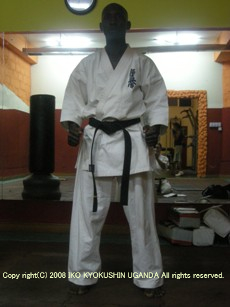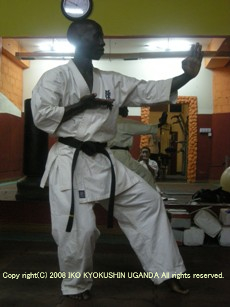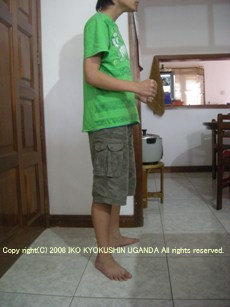1. Heisoku- tachi (blocked foot stance)
In this stance, the feet are held tightly together with the spine and neck
in a straight line. The arms should drop naturally to the sides and the
fists should be clenched. In this, as in all stances, you must always face
straight ahead relax in the inner self by blocking out all thoughts.
Page top |
 |
 |
|
2.
Musubi-tachi (open foot stance)
This stance is identical to Heisoku-tachi except that
the heels are touching, and the toes are separated at a 60 degree angle. This
stance is often used at the beginning of Kumite and kata.
|
 |
 |
|
3. Heiko-tachi (parallel foot stance)
The feet are separated to the shoulder width and the toes are pointed straight
ahead. This is a common stance used for both attacking and defending.
|
 |
 |
|
4.
Zenkutsu-tachi (forward stance)
In this position, one leg extends behind the body with the knee kept straight
and the foot turned outwards. Lean the upper body forward slightly, and
bend the front leg. The distance from the left to the right between the
two legs should equal the width of the shoulders.
Page top |
 |
 |
|
5.
Kokutsu- tachi (back stance)
Extend one leg forward so that only the toes are touching the floor. The
back leg is bent and hips dropped. Two-thirds of the body weight is supported
by the back leg .The front foot is pointed to the front and the back foot
turned outwards. The legs are shoulder width apart.
|
 |
 |
|
6. Fudo-tachi (ready stance)
This stance is same as Heiko-tachi except that the
feet are both turned outwards. The shoulders should be naturally relaxed as
this is a preparative stance for action to follow.
Page top
|
 |
 |
|
7. Shiko-tachi (Sumo stance)
This is a basic stance derived from sumo wrestling.
The legs are spread apart to twice the width of the shoulders, with the knees
bent and the feet turned outwards. The hips are dropped and the spine is
straight. The upper body should be supported by the hips. In this position (as
well as the next one),the center of gravity is much more than in most other
stances. Therefore, you must have strong legs and hips for good balance. For
obvious reasons, this is not a good stance for executing swift kicking
techniques.
|
 |
 |
|
8. Kiba-stance (horse stance)
This stance is the same as Shiko-tachi except that the feet are pointed
forward and tension is placed on the inner part of the feet. The position
is similar to that of riding a horse.
|
 |
 |
|
9. Sanchin-tachi (fighting stance)
This is a common practice stance. One foot is placed one step forward so that its heel is on the same horizontal line as the toes of the same back foot. Both feet are turned in. The distance between the toes of each foot is shoulder width. The tension is placed along the inner of the feet, allowing for a very stable posture. The photos below how to convert from Heiko-tachi to Sanchin-tachi by bringing one foot towards the other using the circular motion so that the feet briefly touch and then separate. The moving foot should end up one step in front and to the side of the stationary foot.
Page top
|
 |
 |
1 |
1 |
2 |
2 |
3 |
3 |
4 |
4 |
10. Tsuru-ahsi-tachi
(crane stance)
Here, the body is supported on one leg. The sole of the raised foot is
placed against the inside if the knee, like a crane standing on one leg.
In this stance, you should be ready to strike with Yoko-geri (side kick)
and Uraken (back fist). This is a transitional stance between a period
of defense and attack. |
 |
 |
|
11. Uchi-hachiji-tachi (inner finger 8 stance)
This is named for resemblance of the position of the
feet to the Japanese character for the numeral 8. The feet are shoulder width
apart, with the toes turned in and the knees turned out. The tension should be
placed along the inner edges of the feet, spine, and the sides.
|
 |
 |
|
12.
Soto-hachiji-tachi (outer finger 8 stance)
This is similar to Fudo-tachi (ready
stance) except that the feet are wider apart and therefore the stance is more
stable.
|
 |
 |
|
13. Kake-ashi-tachi (hooked foot stance)
Like Tsuki-ashi-tachi, this is a transitional stance used to smooth out conversions from one movement to another. Starting from any stance, move one leg backwards and place it as if hooking it behind the knee of the other leg. Only the toes touch the ground- the back of the foot should be raised. This stance enables you to do one of the two things- to either drop back one step or to prepare for executing a kick.
Page top
|
 |
 |
|
14. Futa-ashi-tachi (two legged -stance)
Send with the feet one shoulder width apart. Place one
foot just in front of the other with the toes pointing forward. The knees should
be relaxed, making this a rather loose and versatile preparative stance.
|
 |
 |
|
15.
Neko-ashi-tachi (cat stance)
This stance is very similar to Kokutsu-tachi except that the distance between
the front and back feet is narrower. Ninety percent of the body weight
is supported by the back leg. Because the front leg is held very loosely,
its great flexibility allows for very successful kicks. It is generally
true that the narrower the stance, the faster the leg action.
|
 |
 |
|
16. Shumoku-tachi orToboku-tachi (T- shaped stance)
Place one foot with the toes pointing straight forward. Place the second
foot perpendicular to the first, making a ninety degree angle. The heels
of both feet are touching, and the body faces directly forward.
|
 |
 |







